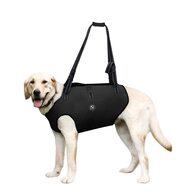 Old dogs often experience a decline in their physical abilities and health, which can impact their ability to keep up on walks and necessitate extra special care. This change is a natural part of the aging process in dogs, just as it is in humans. According to VCA Hospitals: Small dogs are considered senior citizens of the canine community when they reach 11-12 years of age. Their medium-sized friends become seniors at 10 years of age. Their larger-sized colleagues are seniors at 8 years of age. And, finally, their giant-breed counterparts are seniors at 7 years old. Here are several reasons why older dogs might struggle with walks and require more attention: 𝐉𝐨𝐢𝐧𝐭 𝐏𝐫𝐨𝐛𝐥𝐞𝐦𝐬: One of the most common issues in older dogs is arthritis, a condition that causes joint pain and stiffness. This can make it difficult and painful for them to walk, run, or even stand. Regular, gentle exercise can help, but care must be taken not to overexert an arthritic dog. 𝐃𝐞𝐜𝐫𝐞𝐚𝐬𝐞𝐝 𝐒𝐭𝐚𝐦𝐢𝐧𝐚 𝐚𝐧𝐝 𝐌𝐮𝐬𝐜𝐥𝐞 𝐌𝐚𝐬𝐬: As dogs age, they naturally lose some of their stamina and muscle mass. This decline can make it hard for them to keep up on longer walks. Older dogs may tire more quickly and need shorter, more frequent walks instead of long excursions. 𝐒𝐞𝐧𝐬𝐨𝐫𝐲 𝐃𝐞𝐜𝐥𝐢𝐧𝐞: Aging can also affect a dog's senses. Loss of hearing and vision can make walks more challenging and potentially frightening for an older dog. They may become more anxious or hesitant, especially in unfamiliar or busy environments. 𝐂𝐡𝐫𝐨𝐧𝐢𝐜 𝐇𝐞𝐚𝐥𝐭𝐡 𝐈𝐬𝐬𝐮𝐞𝐬: Older dogs often have chronic health issues such as heart disease, kidney disease, or other conditions that can affect their energy levels and overall health. These conditions may require specific care routines and can limit the amount and intensity of exercise they can safely handle. To care for an older dog, it's important to adapt to their changing needs. Suggestions:
0 Comments
Leave a Reply. |
Archives
July 2024
Categories |


 RSS Feed
RSS Feed